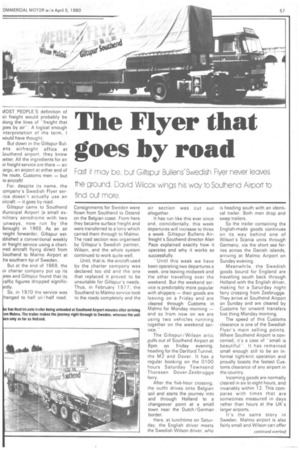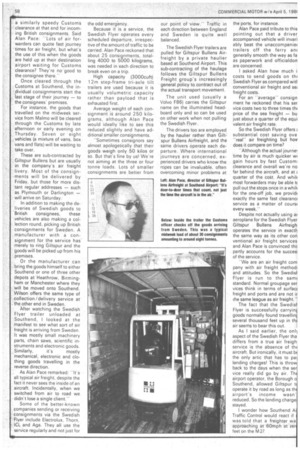The Flyer that oes by road
Page 59

Page 60

If you've noticed an error in this article please click here to report it so we can fix it.
■ AOST PEOPLE'S definition of 3ir freight would probably be along the lines of "freight that joes by air". A logical enough nterpretation of the term, I would have thought.
But down in the Giltspur Bulens airfreight office at ;outhend airport, they know )etter. All the ingredients for an ljr freight service are there — air :argo, an airport at either end of he route, Customs men — but lo aircraft!
For, despite its name, the :ompany's Swedish Flyer serrice. doesn't actually use an iircraft — it goes by road.
Giltspur came to Southend Ounicipal Airport (a small exnilitary aerodrome with two :unways, now run by the 3orough) in 1968. As an air reight forwarder, Giltspur estiblished a conventional weekly air freight service using a chartred aircraft flying direct from 3outhend to Malmo Airport at :he southern tip of Sweden.
But at the end of 1969, the lir charter company put up its ates and Giltspur found that its raffic figures dropped significntly.
So, in 1970 the service was hanged to half air/half road. Consignments for Sweden were flown from Southend to Ostend on the Belgian coast. From here they became surface freight and were transferred to a lorry which carried them through to Malmo. The road section was organised by Giltspur's Swedish partner, Wilson, and the whole system continued to work quite well.
Until, that is, the aircraft used by the charter company was declared too old and the one that replaced it proved to be unsuitable for Giltspur's needs. Thus, in February 1977, the Southend to Malmo service took to the roads completely and the air section was cut out altogether.
It has run like this ever since and, coincidentally, this week departures will increase to three a week. Giltspur Bullens Airfreight's Southend director Alan Pace explained exactly how it operates and why it works so successfully.
"Until this week we have been operating two departures a week, one leaving midweek and the other travelling over the weekend. But the weekend service is predictably more popular with shippers — their goods are leaving on a Friday and are cleared through Customs in Malmo for Monday morning — and so from now on we are using two vehicles running together on the weekend service."
The Giltspur/Wilson artic pulls out of Southend Airport at 8pm on Friday evening, heading for the Dartford Tunnel, the M2 and Dover. It has a regular booking on the 0100 hours Saturday Townsend Thoresen Dover-Zeebrugge ferry.
After the fiv.e-hour crossing, the outfit drives, onto Belgian soil and starts the journey into and through Holland to a changeover point at a small town near the Dutch/German border.
Here, at lunchtime on Saturday, the English driver meets the Swedish Wilson driver, who is heading south with an identical trailer. Both men drop and swap trailers.
So the trailer containing the English-made goods continues on its way behind one of Wilson's Scania units through Germany, via the short sea ferries across the Danish islands, arriving at Malmo Airport on Sunday evening.
. Meanwhile, the Swedish goods bound for England are travelling south back through Holland with the English driver, making for a Saturday night ferry crossing from Zeebrugge. They arrive at Southend Airport on Sunday and are cleared by Customs for onward transfers first thing Monday morning.
The speed of this Customs clearance is one of the Swedish Flyer's main selling points. Where Southend Airport is concerned, it's a case of "small is beautiful". It has remained small enough still to be an informal tight-knit operation and proudly boasts the fastest Customs clearance of any airport in the country.
Incoming goods are normally cleared in six to eight hours, and invariably within 12. This compares with times that are sometimes measured in days rather than hours at the UK's larger airports.
It's the same story in Sweden. Malmo airport is also fairly small and Wilson can offer continued overleaf • a similarly speedy Customs clearance at that end for incoming British consignments. Said Alan Pace: "Lots of air forwarders can quote fast journey . times for air freight, but what's the use of this when the goods are held up at their destination airport waiting for Customs clearance? They're no good to the consignee there."
Once cleared through the Customs at Southend, the inclividual consignments start the last stage of their journey — to the consignees' premises.
For instance, the goods that travelled on the midweek service from Malmo will be cleared through the Customs by late afternoon or early evening on Thursday. Seven or eight vehicles (a mixture of vans, box vans and flats) will be waiting to take over.
These are sub-contracted by Giltspur Bullens but are usually in the company's air freight livery. Most of the consignments will be delivered by Friday, but those for more distant regular addresses — such as Plymouth or Darlington — will arrive on Saturday.
In addition to making the deliveries of Swedish goods to 'British consignees, these vehicles are also making a collection round, picking up British consignments for Sweden. A manufacturer with a consignment for the service has' merely to ring Giltspur and the goods will be picked up from his premises.
Or the manufacturer can bring the goods himself to either Southend or one of three other depots at Heathrow, Birmingham or Manchester where they 'will be moved onto Southend. Wilson offers the same type of • collection/delivery service at the other end in Sweden.
'After watching the Swedish Flyer trailer unloaded at Southend, I looked at the manifest to see what sort of air • freight is arriving from Sweden. It was mostly small machinery parts, chain saws, scientific instruments and electronic goods.
Similarly, it's mostly Mechanical, electronic and clothing goods travelling in the reverse direction.
As Alan Pace remarked: "It's all typical air freight, despite the fact it never sees the inside of an aircraft. Incidentally, when we switched from air to road we didn't lose a single client.'
Some of the better-known
• companies sending or receiving consignments via the Swedish " Flyer include Electrolux, Thorn, ICL and Aga. They all use the service regularly and not just for the odd emergency.
Because it is a service, the Swedish Flyer operates every scheduled departure, irrespective of the amount of traffic to be carried. Alan Pace reckoned that about 25 consignments, totalling 4000 to 5000 kilograms, was needed in each direction to break even on a trip.
High capacity (3000cuft) 12m step-frame tri-axle tilt trailers are used because it is usually volumetric capacity rather than payload that is exhausted first.
Average weight of each consignment is around 250 kilograms, although Alan Pace would ideally. like to see this reduced slightly and have additional smaller consignments.
"Sometimes consignors say almost apologetically that their goods weigh only 50 kilos or so. But that's fine by us! We're not aiming at the three or four tonne loads. Lots of smaller consignments are .better from
our point of view." Traffic in each direction between England and Sweden is quite well balanced.
The Swedish Flyer trailers are pulled for Giltspur Bullens Airfreight by a private haulier based at Southend Airport. This sub-contracting of the haulage follows the Giltspur Bullens Freight group's increasingly general policy to contract out of the actual transport movement.
The unit used (usually a Volvo F86) carries the Giltspur name on the illuminated headboard only and so can be used on other work when not pulling the Swedish Flyer.
The drivers too are employed by the haulier rather than Gilt-. spur Bullens Airfreight, and the same drivers operate each departure. Where international journeys are concerned, experienced drivers who know the ropes can be invaluable, often overcoming minor problems at
the ports, for instance.
Alan Pace paid tribute to this pointing out that a driver accompanied vehicle will invari ably beat the unaccompanie( trailers off the ferry an generally smooth the way as fa as paperwork and officialdon are concerned.
I asked Alan how much i costs to send goods on th( Swedish Flyer as compared wilt conventional air freight and sei freight costs.
For an -average" consign ment he reckoned that his ser vice costs two to three times th( price of the sea freight — bu just about a quarter of the equi valent air freight rate.
So the Swedish Flyer offers substantial cost saving ove "real" air freighting but hovi does it compare on time?
-Although the actual journe■ time by air is much quicker w( gain hours by fast Custom: clearance and overall we're no far behind the aircraft, and at quarter of the cost. And whil( most forwarders may be able t( pull out the stops once in a whil( for the one-off job, we providi exactly the same fast clearanc( service as a matter of cours( every week."
Despite not actually using ar aeroplane for the Swedish Flyer Giltspur Bullens Airfreigh operates the service in exactl), the same way as its other con ventional air freight services and Alan Pace is convinced thil partly accounts for the succes: of the service.
"We are an air freight corn pany with air freight method: and attitudes. So the Swedist Flyer is run to the sam( standard. Normal groupage ser vices think in terms of surfac( freight and ports and are not ir the same league as air freight."
The fact that the Swedist Flyer is successfully carryinc goods normally found travellinc several thousand feet up in th( air seems to bear this out.
As I said earlier, the onl) aspect of the Swedish Flyer tha differs from a true air freigh. service is the absence of th( aircraft. But ironically, it must b( the only artic that has to pa) landing charges! This is throw back to the days when the ser vice really did go by air. TN airport operator, the Borough o Southend, allowed Giltspur t( operate it by road as long as th( airport's income wasn' reduced. So the landing charge stayed.
I wonder how Southend Ai Traffic Control would react if i was told that a freighter wa approaching at 60mph at zen feet on the M2?




































































































